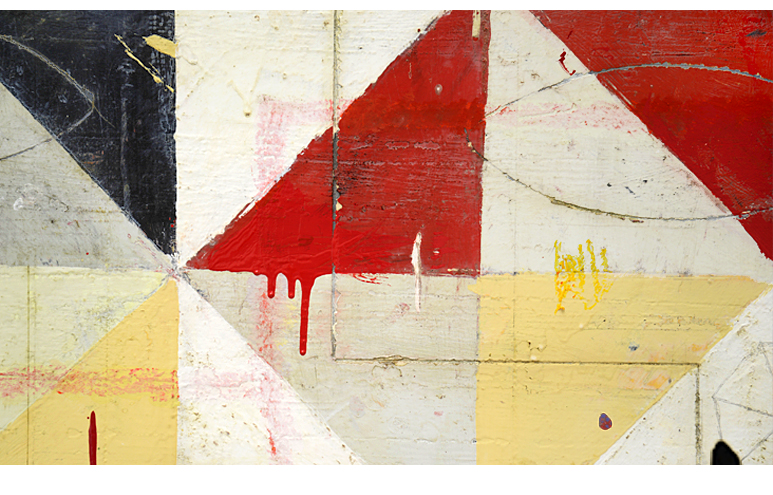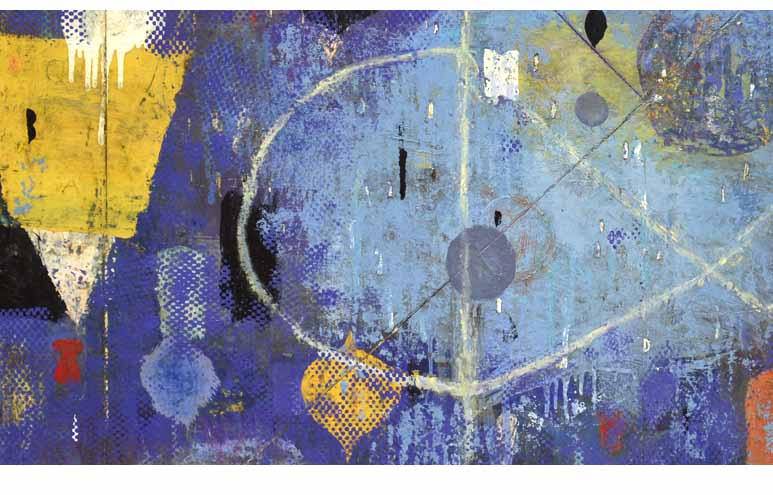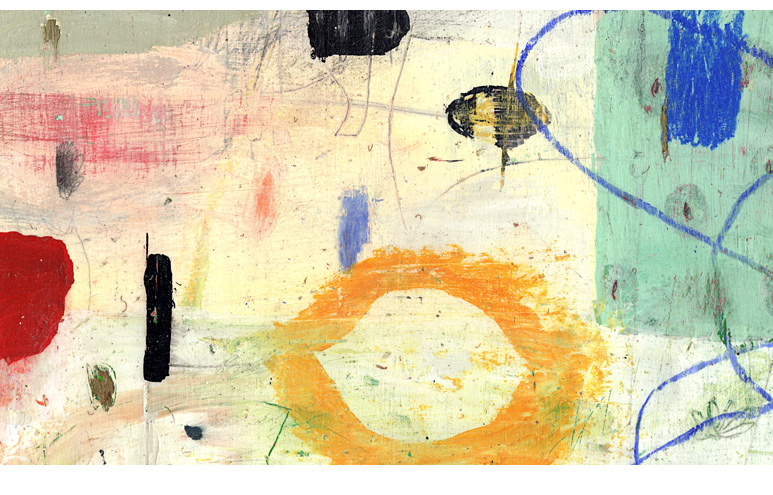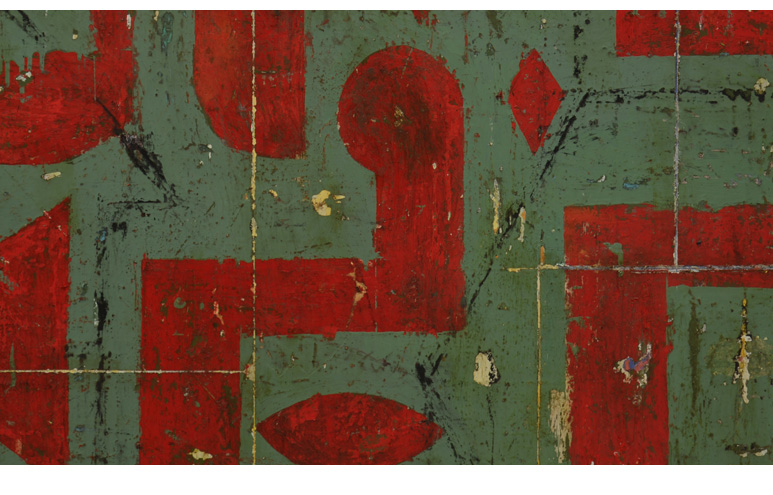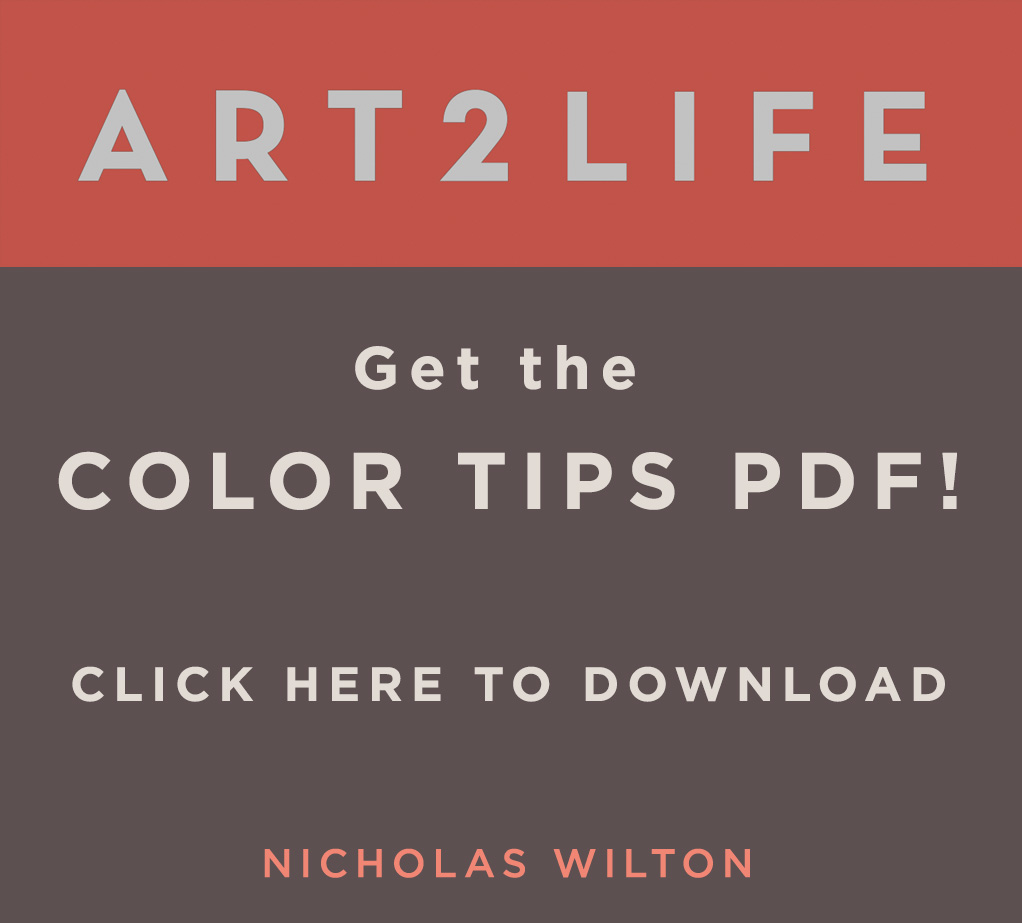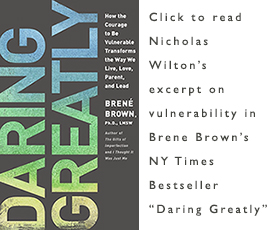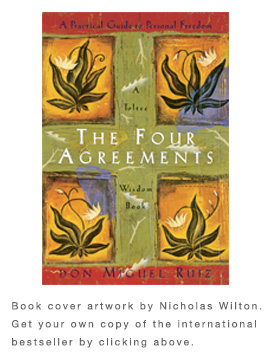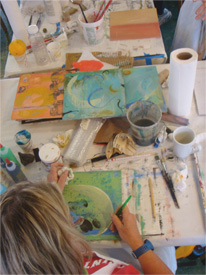How the Right Studio Improves your Art
My very first studio was my kitchen table in an apt in NYC. Then I moved it into an extra bedroom, which once outgrown, I next moved into the attic space. I remember that space was very hot in the summer and way too cold in the winter. I finally set up a studio in the living room of my house and then finally the garage. It took quite a few years before I finally had the courage to rent and move into someone else’s bigger garage and after that into an entirely separate building full of other artists. With each move my working space improved. Every time I gained additional space, better lighting, and generally a more uplifting work environment.
Each move, however, was always preceded by a degree of fear. It just felt scary. I never could afford it; the timing was not perfect and interestingly I thought my work was not actually at the point that warranted moving into a larger space. It was almost like I didn’t deserve it.
However, it was just something I felt I needed to do. I felt kind of cramped. I wanted more room so I could see my work from a distance. I felt the container – the current space for my growing work – was physically and psychologically too small. Ever so slowly I would come to the decision to finally move.
Looking back now, I understand the connections between creating my best art and having the right studio space.
Here then, are the three connections I have since learned about making my best art and having adequate studio space. I wish I knew then what I know now.
#1 If you begin to feel cramped move now.
Like a frog who will happily sit in a pot of water on a stove that is slowly heating up, the frog just gets used to the hot water and never figures out it is time to leave before it is too late—sometimes we can put up with cramped conditions, to the detriment of our work and mental health way too long. If you are not feeling happy in the space for whatever reason, move as soon as possible. It is time.
#2 A better space creates better Art.
I used to think that once I was painting successfully bigger and bolder, I would then be ready for a bigger, more uplifting studio space. Well I now realize that the bold and bigger work only came AFTER my move. In other words, I had to experience spaciousness, bigness in my environment in order to create work that felt that way.
#3 It never seems affordable.
I am always amazed that every time I wanted to move it always felt too expensive. I always wondered if the new space was just a little too big and that surely it was possible for me to find a smaller more affordable space. And then once moved, within a matter of days I felt absolutely at home, enjoying the benefits, not just of how I felt but how my work seemed to almost magically improve. Better, almost always, costs more. It feels the most expensive the day before you move in but in no short time the benefits will overwhelm the new more expensive reality, often because your improved work and brightened attitude help generate sales or income producing opportunities. It just always seems to work out.
I bring these points up in hopes that some of you, who might just need that extra nudge, take that big step towards the next better work environment. It can make all the difference in the world.
How does your studio space affect your work? Do you find you enjoy working in a smaller space, or are you looking for something bigger?
In gratitude, Nicholas
How to Know When Your Art is Done
There is an understandable degree of concern embedded in knowing when our Art is done. Are we possibly overworking our Art? Or equally worrisome, maybe we are not pushing our Art far enough.
I often keep going way too long, invariably driving over that endpoint. I just don’t stop in time. I then end up creating an entirely new painting that still doesn’t have an endpoint. I feel I make 3–4 paintings that all could of ended before the 2nd or 3rd began. Overworking something is no fun at all. It also feels forever unsatisfying looking at your art that is just missing something. I know because I have done both.
Here are my three guidelines I use to help me know when I am done. I hope some of these might be helpful for you.
1 Your Art is strong up close and far away.
Your finished art not only looks strong from across the room but as you approach and get closer, it should also remain strong. The “loud conversation” – the bold marks, the high contrast of light and dark patterns – can be seen clearly from far away. These bold marks should be equally balanced by more subtle, minimally contrasting marks – “the quiet conversation” – that are only noticeable as the viewer gets closer to the artwork. Both views should be satisfying.
2 You have taken Risks to get there.
Sometimes I am trying to be done mostly so I can just feel done. However, stopping for this reason alone is never satisfying for the long term. Within a few days or even hours, I just know I needed to do more, push further even though that is hard sometimes to admit to myself. Like doing perfect swan dives off the low board, instead of the high dive, it just doesn’t quite feel up to par.
I only consider stopping when I have pushed into an area that feels different or new. I want to feel the aliveness that comes when you are participating in something entirely distinct. This work then becomes a little like a doorway leading to the next paintings, even though they are not even made yet. I look for that spaciousness, that embedded potential in all my finished paintings. If it is not there then I know I have not gone far enough.
3 Your Art feels like all of you
Looking back at the arc of my work I see now that my best work, the work that still holds something for me, seems to show more of who I actually am. These paintings are more holistic in this regard. In other words, you are not necessarily just showing what you can easily do, but also being truthful and allowing the work to show where you struggled, where you are unsure. There is a always a degree of vulnerability with showing the good along with the bad, but I have found its presence makes for much stronger artwork. It somehow feels more truthful, more complete.
It allows you to finally stand back and feel certain that this time, in fact, you are done.
How do you know when your Art is done?
In gratitude, Nicholas
Three Ways Teaching Will Help Your Art Practice
I remember listening to a talk by Ram Dass – the American spiritual teacher and author of the book “Be Here Now” – speaking about personal happiness. At the end of the talk, a man in the back of the room frustratingly described a whole laundry list of problems, from financial to personal, he was facing in his life. Before he finished I knew the question he would pose: how can I, with all the difficulties in my life, ever begin to create happiness? How can I, given my challenges, begin to turn things around?
Ram Dass’ answer was so simple that I never forgot it. Once the man, who was almost in tears, finished, Ram Dass waited till the room was again calm and then he quietly said, “You need to serve. You need to help someone.”
I never forgot these words, especially because at times in my life I have taken this same advice. For me it took the form of teaching. This simple act of giving has been incredibly galvanizing for not just my career in Art but also my Life.
I am writing this today in hopes that it might just plant the seed of an idea that this could be something you too could add into your artistic journey. It is that helpful.
What stopped me for years, however, was the limiting belief that I did not know enough to assume the role of a teacher. What I now know is that regardless of how far along you are, even if you are just beginning, that if you stick to teaching specifically what you enjoy and feel the most comfortable in, then there will always be many, many people who are behind you, who are just not as far along, that you could help.
In other words you are good enough already. Start small, even if it is with just one or two students. Charge something, even if it is nominal, but just start by offering your enthusiasm and your guidance. You will be surprised how many people would just love to be helped along.
There are several huge benefits that very quickly emerge once you begin teaching, even if only in the smallest of ways.
1 You build Authority
If you have to regularly explain to someone about an area of your art, then naturally you will become even more familiar and more assured in your abilities as a teacher. In time this becomes expertise and supplies you with a strong platform to build upon so that your knowledge, your teaching, can grow and become more and more effective. Like your Art, your teaching also improves and becomes stronger with doing. Earning legitimate authority will provide you with self-confidence and tremendous momentum to help more and more people. This authority, not surprisingly, then begins to translate back into your own work, making it stronger and more authoritative in turn.
2 You gain Clarity
Teaching invites you to clarify aspects of your Art Practice that probably till now have been fairly nebulous. For myself, this process of repeatedly clarifying and saying out loud has been incredibly helpful for my own art practice. My best work is always made upon returning from teaching a workshop. When you teach you are constantly saying what you believe to be true, that what is possibly just out of reach is in fact, obtainable. By offering out loud what resonates with you and what you believe to be possible for others, the more easily those same concepts and ideas become true for you. Having clarity is simply a prerequisite for achieving all you desire in your Art.
3 You become filled.
Teaching is an act of giving. It takes energy. This fact can sometimes prevent people from assuming the role of a teacher or mentor. From my experience I have always been amazed that the act of teaching does not really deplete your creative energy. For me, it increases it.
I believe that, at least partly, the reason for this increase in creativity has to do with the “universal law of divine compensation”, detailed so eloquently in Marianne Williamson’s book of the same name. The idea that when we give of ourselves, when we look upon those we can help as more of a calling, as part of our creative purpose as an artist – rather than a job – then the universe tends to favor our circumstances. In short, when we give, we also receive. It is the natural course of things that we shall be replenished energetically, financially or in the form of some wonderful unforeseen possibility.
The fear of depletion rarely comes true. Teaching, helping others who are not as far along as you, can build your creative momentum. It certainly has for me. It also has the possibility to invite a greater sense of artistic community into your life. Best of all, however, it just feels plain wonderful to know that you have actually helped someone.
Most importantly, however, it can provide you with that missing surge of creativity, that sense of personal abundance that doubles back into your own art practice, making what once seemed unattainable in your own artistic journey suddenly entirely possible.
What do you do to refresh and reinvigorate your creative energy?
In gratitude, Nicholas
How to Overcome Obstacles in Your Art Career
I just finished a large body of new work. I have a show coming up in 4 days. Invitations were produced. Some paintings have already sold. I really like what I have made. There have been many conversations with the gallery about pricing, about responses to the work and how the paintings will be hung at the opening.
I even bought a new jacket for the opening. It turned into a several hour ordeal trying to find one that actually fit my tall frame. None did, of course, and so alterations were required. Since June is wedding season, the seamstress brought in to rescue me was incredibly stressed and could only half promise she would be able to pull it off so I could wear it at my opening a mere 4 days away.
Standing on a raised stool in front of a mirror with this panicked woman working around the cuffs of my sleeves, pulling, pinning and tucking the material behind my back, it occurred to me how very far away I presently was from the actual quiet process of making art. And yes, all this peripheral stuff – from promoting your work, occasionally wearing clothes that do not have paint on them as well as trying to create strong Art not just for yourself but also for those who are in the business of selling it – is all part of a career in Art.
But it can sometimes feel hard.
In fact, as I was stuck in traffic driving home afterwards, I was thinking about just how many mini roadblocks seem to pop up in one’s life, especially when you are trying intentionally to make something happen. Involving yourself in a career in Art takes a giant amount of intention. The reserve of energy has to be large enough to overpower the small roadblocks that occur along the way.
Where is this energy, this wave of positivity that can help overcome the obstacles, supposed to come from? It certainly doesn’t come from promoting and talking about your Art. When I spend most of my time on the business side of Art as I have these past few weeks, it is all too easy to forget. Where is the source of intention, faith and positivity? And then I remember. Again.
It comes from making Art. It comes from quiet afternoons in your studio, swimming in the metaphorical world of color, textures, shape and line. It is a world that is a million miles deep but utterly inviting. Art making always seems to reward you with something substantial even if you arrive exactly where you began. It even sometimes gives something unexpected that hints at what is coming but can’t yet be seen.
The roadblocks, in this world, can be more easily over come, as they are your own creation. They lightly topple over when met with new learning. And this maybe is at the heart of it; that learning discovered along the way – our own way – is what makes a career in Art so fulfilling.
At the end of the day it is those still moments, usually when you are by yourself in the quiet of your studio, when you just know that you understand a little bit more. It is clear that above everything else you are continuing to improve and learn. That somehow after all these years, all the tries, that today you got it, the penny has finally dropped. You understand a little bit more. And now your work will never be quite the same again. It is becoming stronger.
Your Art has changed, just when you thought it never could, and not surprisingly, you have too.
In gratitude, Nicholas
What Everyone who Loves your Art Wants to Know
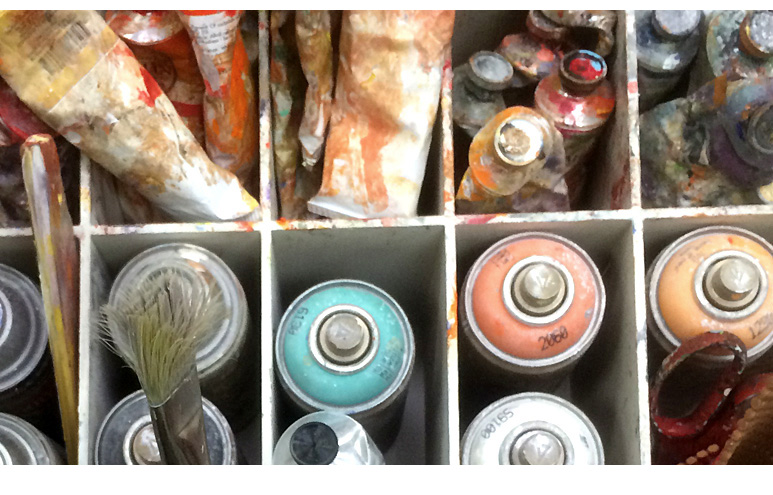 The more people who know and follow your Art the easier it will be to sell your Art.
The more people who know and follow your Art the easier it will be to sell your Art.
I used to put a lot of pressure on myself to always make stronger and stronger Art so that this small but growing audience would continue to stay engaged. I thought that the only way to keep people interested in what I was doing was to be always churning out better and better Art. Every couple of weeks I would send out an email with a new painting.
The only problem was that sometimes my work wasn’t better. Sometimes I felt stuck and actually made things that I didn’t want to show anyone. As a result I would put off promoting my work, which led to losing touch with people.
I tried to appear consistent and highly creative but in actual fact I wasn’t. I needed chunks of time away from my studio. I needed vacations from my art practice. I needed to talk to other artists. I needed to look at other artists’ work to get re inspired. Sometimes I just wanted to doodle in my sketchbook with no particular plan at all. Sometimes I didn’t even feel like making Art and instead wanted to just go on a hike.
All this inconsistency used to bother me. I didn’t want to give the appearance to my audience that I wasn’t a serious, productive artist. It was a real problem for me and I grew tired of trying to appear different than I actually was.
And then I discovered something about my audience (and I am pretty certain yours too) that changed everything for me. It changed how I related to them. It made it much easier to remain motivated in promoting my work. It also prompted those who found out about my work to share it more, which has lead to a bigger and bigger audience for my work.
What I discovered about my audience was quite surprising. I found out that most people who are interested in my art are equally interested in the process of how my Art is made. Not just the actual painting part, but all the time in between as well. People want to know what I saw on that hike that translated into a painting, they want to know what you are talking about with other artists, they want to know how you feel when you are on vacation and then what happens in the studio when you come home. They want to know how you find your way back to your art and what it feels like when you get there again.
All the things you do, feel and experience that end up re energizing your Art are great content for those who are interested in your Art.
People will love and follow your Art not just because of the Art, but also because of the unfolding story around the process you go through to make it. Making art is a bid for connection with the outside world. If the artist can share more of what goes into the personal process of making the art it allows people peering into your world to connect better with you. And this connection is vitally important if someone is going to spend, not just their time, but also their money on your Art.
Just like your best Art, making your best promotion has a lot to do with letting the world truly see you. Your audience wants to see the breakthroughs but they are especially interested in the time in between. It is ok to show the challenges, the timid attempts at something new or even the dismal failures. It makes you human. It makes you more like them and as a result they will more easily connect with you and as a result, your Art.
How do you connect and engage with your audience? Please share your thoughts and comments below.
In gratitude, Nicholas
Make Amazing Color in your Art Practice
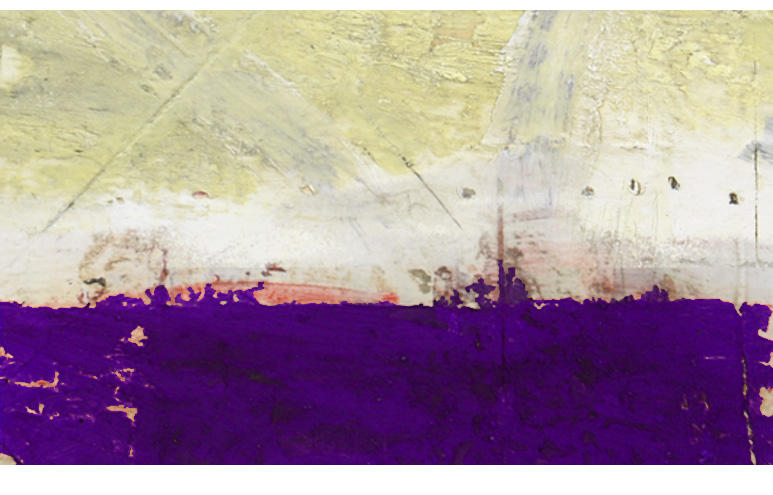 Why do some colors look better than others? When purchasing paint at the art store, I used to think that the more expensive colors were somehow better. I reasoned that if I used these colors in my paintings they would magically look great. Unfortunately, over time, I realized that making great color was not so simple.
Why do some colors look better than others? When purchasing paint at the art store, I used to think that the more expensive colors were somehow better. I reasoned that if I used these colors in my paintings they would magically look great. Unfortunately, over time, I realized that making great color was not so simple.
It turns out color only looks good (or bad) because of its relationship with the existing colors around them. In other words, it is relative. Color can look breathtakingly gorgeous but usually because it is surrounded by or next to a second color that is simply different.
To help me quickly choose a color that will look good next to an existing color, especially when I get stuck, I ask myself three questions. This sequence of basic questions is one I teach in my ArtLife workshops, and has often helped me come up with a color choice that totally works. The three are listed below in order of relative strength. In other words, the first question creates the biggest visual difference, followed by the second and lastly, the third.
#1 Is my new color going to be dark or light?
First question. Always. The easiest, most dramatic, powerful way a color can be different from another is to be different in terms of Value (the lightness or darkness of a color). It is kind of odd to think of color in a black and white way, but if you can get in this habit it will actually make your work visually change faster and more efficiently. So for example if there is an existing patch of cadmium light yellow, possibly a dark value color will be a nice complement. Interestingly, if you get the values to contrast between two colors side by side, almost any color choice will work.
#2 Is my new color going to be dull or bright?
This is saturation. How much yellow is in that yellow? Basically remembering that the most saturated color is from the tube when you buy the paint. Lots of yellow color in yellow makes it saturated. When a paint color is filled with other colors, or when white or black are used to make this color, it will be less saturated, less bright and duller. So that existing patch of pale yellow light is quite washed out, it is made with lots of white so most likely the dark value color we are going to add could be quite saturated.
#3 Is my new color going to be warm or cool?
Temperature of color is also relative. The colors – if we imagine a color wheel – that are directly across from one another in the wheel are most unlike each other. Red is most different from green and yellow is most different from purple. Partly the reason why is because of their temperature. Red is warm and green is cool. Reds, yellows and oranges are warmer than greens, blues and purples. This aspect of color – temperature – is a nice one to keep in mind when looking to juxtapose one color with another. So our existing patch of pale yellow light that is dull or washed out would look good or would be complemented well with a #1 dark, #2 saturated, #3 cool color. A dark royal blue, a deep purple or even a bright dark green will all be visually potent neighbors next to our existing patch of cadmium yellow light.
When I am adjusting a painting I am often looking at my color choices to see that they contrast with one another in these three ways. When they do, I know that I am getting the most visual bang for my buck that I can. Or at least I am getting close.
There are no rules in art. However, having a few principles or guidelines or at least understanding visually why sometimes color is working or not has been helpful to me, especially when I feel I am just reworking an area without actually changing it.
One of my favorite parts of making art is playing with color. I hope this series of 3 questions helps you or better yet, maybe you have some other ways of thinking about color that could be helpful to the rest of us.
Please share it here if you do.
With gratitude, Nicholas
How to be Bolder in Your Art Practice
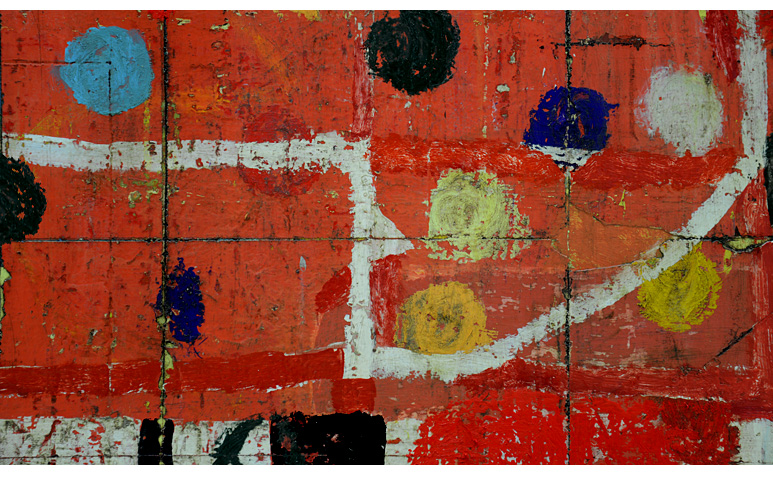 As most of you already know, the lessons learned, the principles at play in the making of Art almost seamlessly transfer to Life. I find that when I am feeling less sure of myself, my art feels somewhat the same. I also see parallels in the business side of making Art. Clarity, intention and passion translate not just into strong Art but also into building a new business, an idea or basically any new venture we desire.
As most of you already know, the lessons learned, the principles at play in the making of Art almost seamlessly transfer to Life. I find that when I am feeling less sure of myself, my art feels somewhat the same. I also see parallels in the business side of making Art. Clarity, intention and passion translate not just into strong Art but also into building a new business, an idea or basically any new venture we desire.
Creatives involved in the highly unconventional practice of making something highly personal and then sharing it with the world are not only artists, but are also entrepreneurs. There is a tremendous amount of outside the box thinking, risk and sheer determination needed not just in creating our Art but also sending it out into the world.
In Peter Diamandis and Steven Kotler’s new book “Bold” they illuminate the common mindsets of entrepreneurs and creatives who are engaged in building groundbreaking businesses, products or ideas.
It got me to thinking. What can we learn from those who build gigantic revolutionary ideas and business that we can then apply to our own creative ventures?
It turns out, one of the most powerful principles that all the entrepreneurs and creatives in the book share – be it Richard Branson, Amazon CEO Jeff Bezos or Elon Musk, the CEO and co founder of Tesla and Pay Pal – has to do with making mistakes.
Always swimming against conventional thinking, they have come to the realization that success comes not in spite of wrong turns but because of wrong turns. Mistakes are an integral part of success. I too see this every single day in my process of making Art, but hadn’t thought of it exactly this same way.
The book “Bold” offers that it is just not the simple idea of accepting mistakes as part of our process, but going even further to realize that the more mistakes, and the rate of mistakes do, in a direct way, determine the likelihood, degree and pace at which success is achieved.
“Fail early, fail often, fail forward.” Summarizes this beautifully. “Real progress requires trying out tons of ideas, decreasing the lag time between trials and increasing the knowledge gained from results,” is also utterly relevant to the practice of making Art. It is also one of the enabling concepts used by those involved in bold, passionate ventures. And in my opinion, this includes Artists.
This specific thinking, this approach in the entrepreneurial, start up, world changing idea realm is known as rapid iteration. The more I think about this idea, the more I see its relevance for the artist/entrepreneur. In my experience and practice, when I have managed to become more confident, more curious to make more and more mistakes, the stronger and not surprisingly the quicker my Art has developed. I didn’t know there was a name for it.
Regardless of whatever stage your practice or career is presently in I think this is a good reminder for artists to remember the hidden benefits all cued up, all just waiting in our upcoming mistakes. Maybe instead of just tolerating or accepting them, we start making more. And maybe we start making them quicker.
And then, because of this heightened rate of learning, authenticity and resulting clarity, our Art will shift, surely and boldly, forward.
What has your experience been with mistakes in your art practice?
In gratitude, Nicholas
Three Stages that lead to Creativity
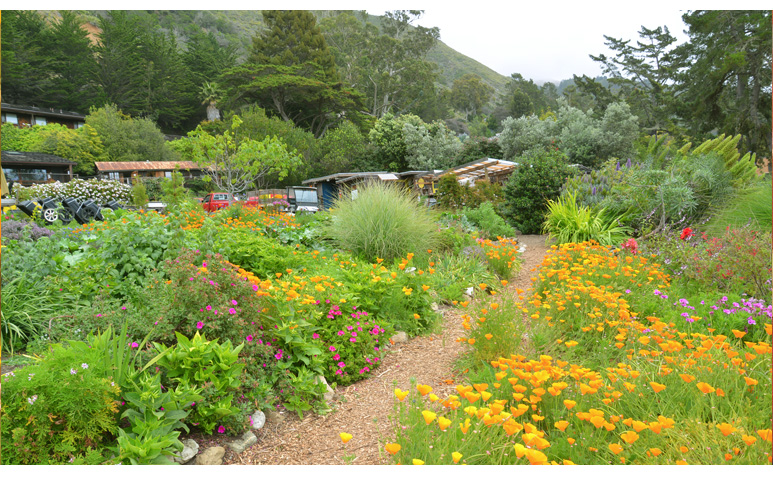 This week I am teaching an Artlife Workshop on the beautiful Big Sur Coast of California, at a retreat center perched upon the cliffs above the sea. It is called Esalen, a name derived from the Native Americans who originally lived here. There are flowering plants and trees that seemingly never go dormant in the moist, semi tropical air. Hot springs still run from the cliffs as they have done for thousands of years, collecting in pools that overlook the constantly changing sea. From here, whales with their calves can be seen returning north.
This week I am teaching an Artlife Workshop on the beautiful Big Sur Coast of California, at a retreat center perched upon the cliffs above the sea. It is called Esalen, a name derived from the Native Americans who originally lived here. There are flowering plants and trees that seemingly never go dormant in the moist, semi tropical air. Hot springs still run from the cliffs as they have done for thousands of years, collecting in pools that overlook the constantly changing sea. From here, whales with their calves can be seen returning north.
Every year I am amazed that so many people somehow pull it off to stop whatever they are doing in their busy lives and manage to come to this workshop. They arrive from many different places, and many different life circumstances, but they all share the same desire. They are all here to find their own path back to their Art.
And year after year, I see that it works.
What exactly is happening that makes it possible?
What is the underlying process at play that returns us to our Creativity?
Regardless of people’s backgrounds or life experience they all enter into a specific process. It is the same one I have observed for years leading these workshops. And amazingly, it just works. This process has three stages. The second two are jump started by the first….
1 Connecting with that which brings you joy.
This sounds simple enough but often we become so busy with all that is practical – instead of joyful – that in no short time, joy is sometimes entirely absent for long stretches of time. It is no surprise that when we free up time to do a few things that we absolutely love that our disposition begins to shift. It is crucial to remember to spend a little time doing anything that fills our spirit, whether it is spending time with a close friend, walking or running in Nature, or just seeking out anything that makes us feel more like ourselves. Joy, it turns out, is waiting right underneath anything we choose to turn over that is a “Yes”.
2 Inspiration follows Joy
I am always surprised how quickly this next stage follows the first. Following Joy, always close on the heels of happiness, comes inspiration. It comes out of having joyful experiences and fills one with a sense of well-being. Inspiration is a sign that your batteries are now charged. This sense of well being, optimism and abundance is more even and tends to remain within you regardless of what you are experiencing. Inspiration just seems to stick around a lot longer than Joy.
It gives us a sense of being filled, like you are going to overflow and that miraculously you have more than you need. And then no sooner has inspiration arrived, that this abundance overflows into the next outcome….
3 Creativity follows Inspiration
And then Creativity arrives. We often think of our own creativity as controlled by some external force that randomly turns it off and on. It feels like we don’t have anything to do with it. And this idea, understandably, causes no small measure of anxiety. However, from my experience, I have found that this elusive state, so desirable, so needed in the life of the creative is just the natural outcome of feeling inspired. The wellness, the aliveness of inspiration is just too big to hold within us and so it is transformed, by us, into something outside of ourselves. Creativity is the force, the juice that enables our Art to manifest.
And of course it is not necessary to go to an exotic place to drop out of your life for a week and re invigorate your Art.
Simply understanding that Creativity is just a natural state of being alive for all human beings should help alleviate that sinking feeling that our well has simply dried up. It hasn’t. Creativity is hard wired into the operating system of all human beings. It just tends to show up more for those whose lives contain some measure of Joy, some moments of happiness from which inspiration is derived, that then overflows, finally, into Creativity.
It just works. Every time.
What has your experience been with joy and creativity? Do you find the two are connected, or do you draw inspiration from somewhere else?
In gratitude, Nicholas
How to Stay More Positive in Your Art Practice
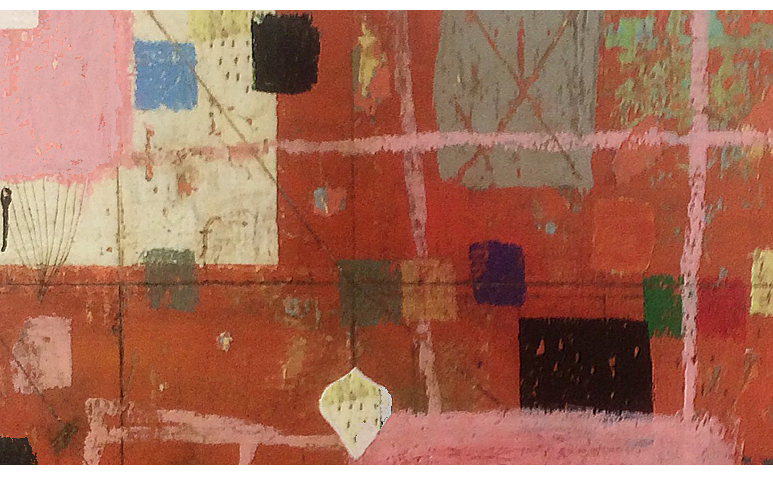 Sometimes we wish for something to happen, but when it finally does, we can feel, oddly, let down.
Sometimes we wish for something to happen, but when it finally does, we can feel, oddly, let down.
I was reminded of this the other day when I ran into an artist friend who had recently sold several paintings from a new series of work she had developed over the past year. I knew this was a huge step for her. She had bravely embarked on a new direction with her paintings and worked for months with little outside support. Few people had even seen the work. But now, she had shown someone, and they bought several. I thought she would be happy, but she wasn’t. Not entirely. After the sale she felt bad because she might not have charged quite enough for her work. Maybe this was true. Or maybe it wasn’t.
So how do we decide what we should celebrate and what we should feel reserved about? What is a Yes! And what is a No?
Here is the litmus test I use to decide whether I should feel good or not so good…
This test works on anything you desire in your Art, your business or any aspect of your life. When one of those steps happen, whether it is selling a piece of your Art for the first time, getting accepted into a juried show or perhaps just making Art thatyou love more than your old work, you need to ask yourself two questions…
1 Has this step ever happened before?
2 Is this step heading in the right direction?
If you answer “No” to the first question and “Yes” to the second, then congratulations! There is no need to feel bad. You already won. In the case of my friend who perhaps could have sold her paintings for a little more, this reservation shouldn’t take away at all from the incredible feat of selling the work. Had she ever sold any of this new body of work? “No!” Does she want to sell more work in the future? Yes!
Therefore, run, don’t walk, directly into your studio, use this success as newfound energy to make even stronger Art. Do not squander your successes when they occur by wanting even more. Take small bites, enjoy them to their fullest and get ready for the next, remarkable step to happen.
Use these hard won steps as celebratory reminders that you are making progress and your dream is actually coming true.
Have any of you experienced something similar to my friend? If so, what did you do afterwards? Did you find you were you inspired, discouraged, or did you feel something else?
In gratitude, Nicholas
The Simple Business Plan to Sell Your Art
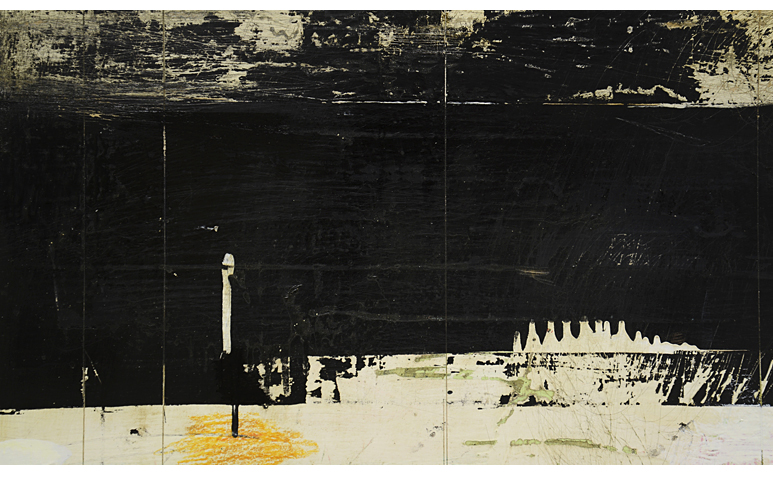 How do you work with the pull between selling and ignoring the art market entirely?
How do you work with the pull between selling and ignoring the art market entirely?
This is an interesting question posed last week by one of my readers. I used to spend a great deal of time struggling with this issue. I know how supremely wonderful it feels to sell a piece of art you have made. Even if you are having the worst day, it can be made wonderful, instantly, by a sale. The problem arises because we like it so much and we want more. And we need more, especially if we are relying on sales to fund the making of our Art.
But that is where it gets trickier. Once the sale of a painting or sculpture is made, that particular piece somehow feels significantly stronger than the remaining unsold ones. The gallery might even lament its loss, exclaiming they could sell 5 more like it if they only had more.
But you only made one. In fact, when you created it you were not even that sure it was any good. Who knew it would be anointed with such grandeur? So you can easily set about to do more like this painting. However, while you are making the additional work it is hard not to compare and wonder if it is as strong as the piece that sold so effortlessly. That one painting that everyone seemed to love. The more you think about it, the more you realize how much you love it too. It seems the whole world loves this one painting and now you do too.
If only you could make more one or two more like it. Surely you can.
Well, I am sorry to say, from my experience, you can’t. And in trying, you end up wasting precious time and energy focused on something very, very different than making Art. You are now focused on the marketing of Art.
It is fine to pay attention to what sells and what doesn’t. It is just not helpful to be thinking about it while you are making your Art.
At first this seems counterintuitive. In most businesses that produce a product you thrive by paying attention to what your customers are buying. And when they buy you just make more. Lots and lots more.
But Fine Art is different. This doesn’t mean it is necessarily harder to sell your Art – in fact I believe that working without regard for the market actually produces stronger work, which to no surprise, sells. And it is easier, much easier to make Art when you are focused solely on what is happening right now in your studio, in the present, in front of you.
It is important and comforting to remember that you, the artist, is utterly in the drivers seat of your own creative process. The more you can safeguard spilling your mental energy on what might sell or might not, the better. Instead, focus on making your art practice about what feels aligned with you. What is so wonderful about this task is that you are already perfectly ready to take this on. Today.
Making your work more and more like you is also the most powerful business strategy for marketing your work. Thank Goodness.
There is only one you, one distinct creative journey you get to walk in your lifetime. If your Art can demonstrate this difference, your uniqueness, then the likelihood for people wanting to buy a small part of your courageous, utterly authentic journey is very high. Your Art, if it can inspire you, will inspire others and that is something that is, without even trying, very, very marketable indeed.
What do each of you focus on when making art? Do you think about what has sold previously, or is it more about the painting itself? Or is your experience something else entirely?
A special thanks to Sara (last name not listed) and all of those in our creative community who are commenting and contributing in response to the ArtLife Blog. It is a benefit to many. -nw
